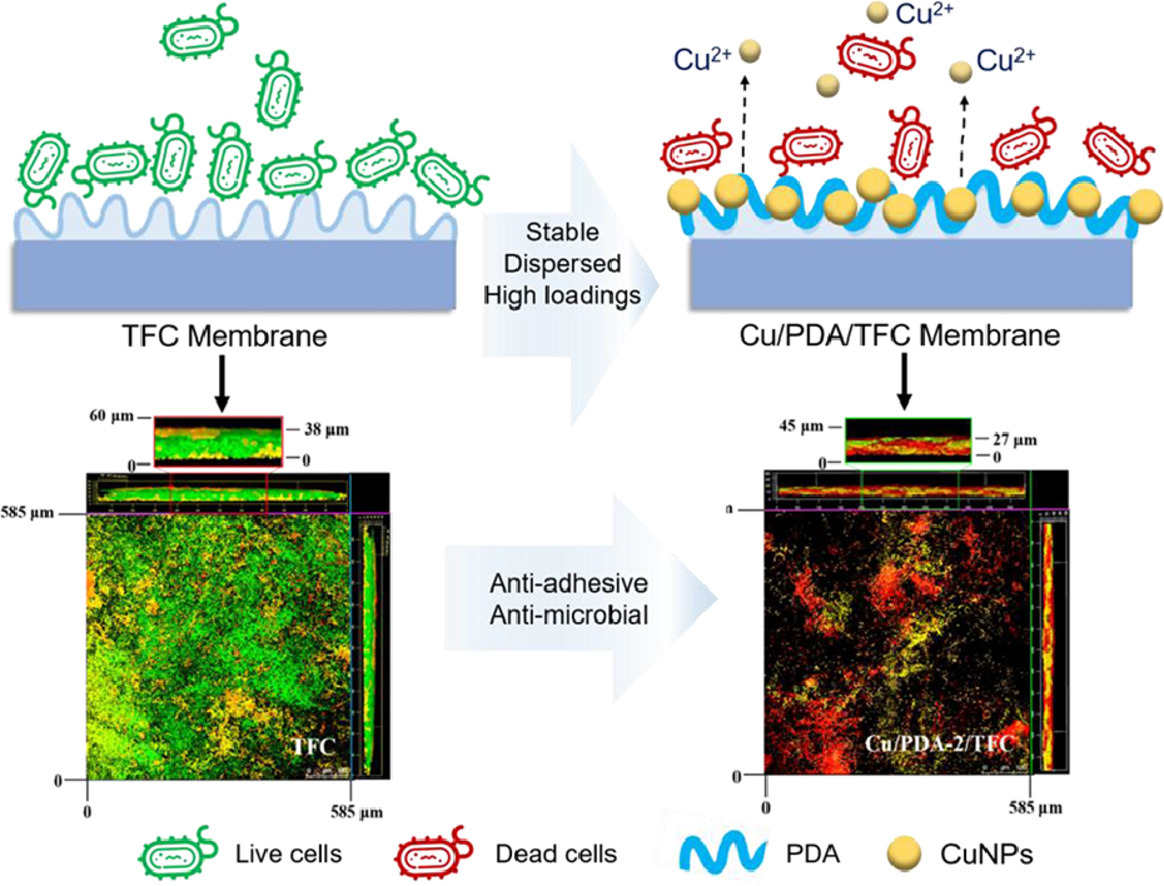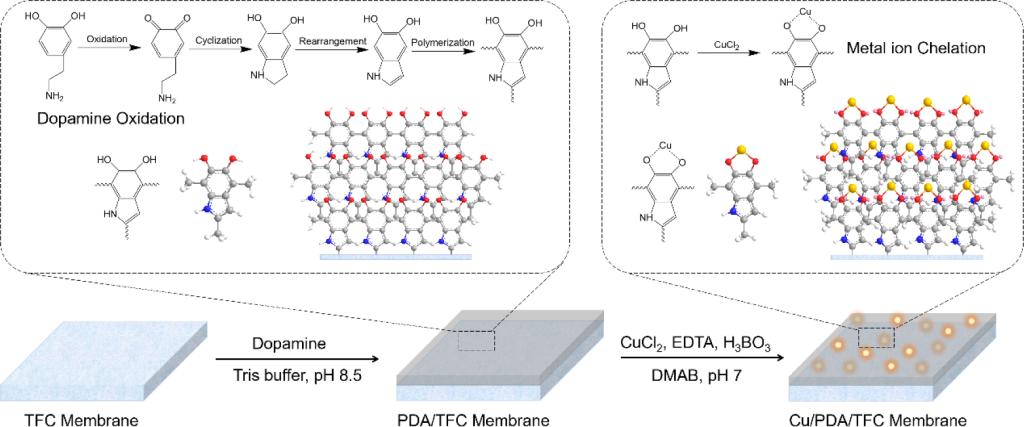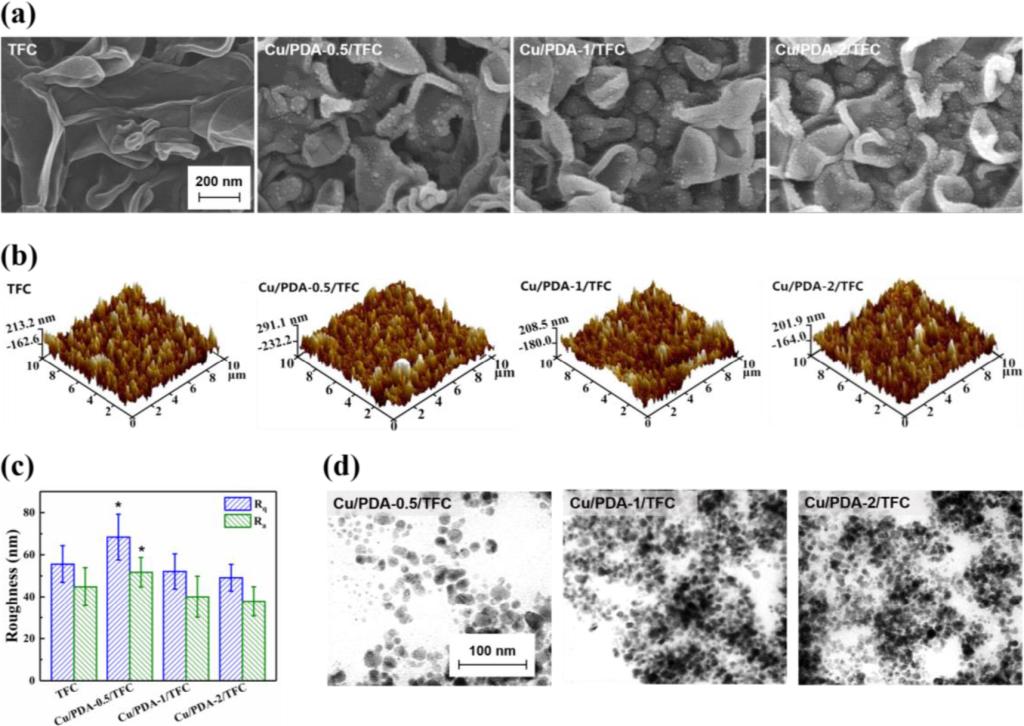2022-04-18 19:53:07
Dr. Caihong Liu’ team from the College of Environment and Ecology, published a study on membrane biofouling mitigation inWater Research, a top academic journal in the field of environment. In this study, highly antimicrobial CuNPs were integrated into a hydrophilic polydopamine (PDA) coating and immobilized on a RO TFC membrane via a mild and facile reduction approach to form a stable and durable dual-functional layer. The well dispersed and high loadings of CuNPs induced by PDA conferred strong bacterial toxicity to the modified membranes, with simultaneous anti-adhesive and anti-microbial properties, leading to a substantial reduction in biofouling propensity in dynamic biofouling experiments. This study provides a facile and versatile strategy to construct high performance RO membranes with excellent anti-biofouling functionality.
https://www.sciencedirect.com/science/article/abs/pii/S0043135422003372
Electroless deposition of copper nanoparticles integrates polydopamine coating on reverse osmosis membranes for efficient biofouling mitigation
Caihong Liu, Qiang He, Dan Song, Jennifer Jackson, Andreia F. Faria, Xihui Jiang, Xueyan Li, Jun Ma, Zhiqiang Sun
Abstract

In this study, highly antimicrobial CuNPs were integrated into a hydrophilic polydopamine (PDA) coating and immobilized on a RO TFC membrane via a mild and facile reduction approach to form a stable and durable dual-functional layer. Based on the XDLVO analysis, the introduction of PDA increased the membrane-foulant total interaction energy (ΔGmwf) to 14.13 mJ/m2, resulting in improved anti-adhesive properties as demonstrated by a 37% decrease in BSA adsorption for the modified membranes. The well dispersed and high loadings of CuNPs induced by PDA conferred strong bacterial toxicity to the modified membranes, reducing the viability ofE. coliby 76%. Furthermore, the presence of catechol groups on PDA favors the formation of covalent bond with CuNPs, thus prolonging the durability of the copper-based anti-biofouling membranes. The combination of PDA coating and CuNPs functionalization imparts the membrane with simultaneous anti-adhesive and anti-microbial properties, leading to a substantial reduction in biofouling propensity in dynamic biofouling experiments. Specifically, the flux decline due to biofouling observed for the modified membranes significantly decreased from 65% to 39%, and biofilm thickness and TOC biomass were 58%, and 55% lower, respectively. This study provides a facile and versatile strategy to construct high performance RO membranes with excellent anti-biofouling functionality.
Aims
This work aimed to propose a versatile and mild reduction method to fabricate CuNPs by boric acid with ethylenediamine tetraacetic acid (EDTA) under weakly alkaline and room temperature conditions, enabling the formation of highly dispersed CuNPs without destroying membrane substrates. To increase copper loading dosage and stability, we introduced mussel-inspired PDA as an adhesive coating before CuNPs deposition, where copper could coordinate with catechol groups on PDA coating. As the leaching of toxic metal ions has been regarded as a dominant antimicrobial mechanism of nanoparticles-based coatings, in this case, the presence of PDA layer might bind with copper and retard the release of toxic Cu2+, thus enhancing the durability and prolonging the antibacterial properties of PDA-CuNPs layer. Moreover, PDA grafting would also serve as a hydrophilic functionalization, strengthening the anti-biofouling potential of modified membranes apart from the antimicrobial properties provided by CuNPs. The proposed PDA-CuNPs membrane modification approach may facilitate the immobilization of CuNPs with high loadings and dispersion, and simultaneously offers anti-adhesive and anti-microbial properties to maximally combat TFC RO membrane biofouling. Based on these hypotheses, we took a series of characterizations to identify the possible synergistic effects between PDA coating and CuNPs immobilization and relevant influence on membrane anti-biofouling properties under varied conditions. Firstly, scanning electron microscopy (SEM) and transmission electron microscopy (TEM) were conducted to evaluate the dispersion, loading and stability of functionalized CuNPs. Secondly, the role of PDA immobilization was elaborated by the XDLVO theory. Finally, static adsorption assays, dynamic RO biofouling experiments and biofilm composition were systematically investigated to reveal the synergy of CuNPs and PDA in combating biofouling.

Fig.1.Schematic illustration of the preparation of Cu/PDA/TFC membrane. The pristine TFC membrane was first coated with mussel-inspired polydopamine (PDA), followed by immobilization of CuNPs via electroless deposition. Reaction time for PDA immobilization was 0.5, 1 and 2 hours, respectively, while that for CuNPs deposition was 2 hours. The dopamine oxidation process included oxidation, addition cyclization, rearrangement, and polymerization.

Fig. 2.Surface characteristics of the pristine TFC, modified Cu/PDA-0.5/TFC, Cu/PDA-1/TFC and Cu/PDA-2/TFC membranes. (a) SEM images. (b) 3D AFM images. (c) Roughness parameters acquired from AFM imaging, where Rq and Ra stand for the root mean-square roughness and average roughness, respectively. Asterisks (*) indicate that roughness parameters of the Cu/PDA-0.5/TFC membrane was statistically significantly different from that of the pristine TFC membranes (p<0.05). (d) TEM images of three modified membranes.
Conclusion
This study proposed a facile and versatile RO membrane modification strategy by a mild electroless deposition of CuNPs integrated with PDA coating to combat biofouling. Various surface characterization techniques were applied to investigate the physical and chemical properties of modified membranes. The anti-biofouling properties of membrane modification were demonstrated by static/dynamic biofouling experiments, XDLVO theory and biofilm CLSM analysis. Static protein adsorption assays indicated that modified membranes displayed less propensity for protein adsorption, with an observed reduction of 37% for the Cu/PDA-2/TFC membrane. As revealed by XDLVO analysis, the presence of PDA significantly increased the membrane-foulant total interaction energy (ΔGmwf) by 27%. Antimicrobial experiments indicated that the toxic CuNPs functionalized on the membrane surface significantly inhibited microorganisms, reducing the cell viability on Cu/PDA-2/TFC membranes by 76% compared to the control. Furthermore, the regeneration of CuNPs on the membrane after depletion of copper from the surface of the complex was demonstrated. Moreover, based on the results of the dynamic RO biofouling experiments, membrane functionalization substantially reduced flux decline by 40% without compromising membrane transport properties. The construction of PDA-CuNPs dual functional layer effectively inhibit biofilm development under cross-flow conditions, with biofilm thickness and TOC biomass reduced by 58%, and 55%, respectively.